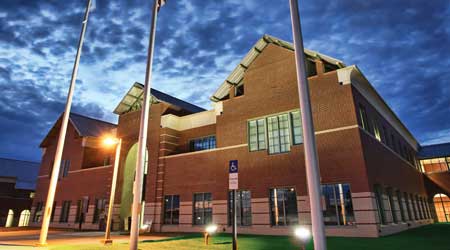 Tulsa Community College’s facilities department helped the college surpass a state initiative on energy efficiency.Tulsa Community College
Tulsa Community College’s facilities department helped the college surpass a state initiative on energy efficiency.Tulsa Community CollegeCollege Rethinks Maintenance, Embraces Energy Efficiency
A college-wide effort and a resourceful maintenance department were essential elements in achieving energy-efficiency success
The low-hanging fruit had been picked. The easy money was already in the bank. The no-brainers had been thought of long ago.
For the facilities department at Tulsa Community College, the initiative from the Oklahoma governor to reduce energy use among its agencies and institutions came at exactly the wrong time. The department had just completed a number of energy-efficiency projects throughout the college’s four campuses via an energy performance contract, many of which had targeted the usual suspects of energy upgrades — lighting and HVAC systems.
“The unfortunate part of that was that when the state came out with their initiative, we had just experienced (the upgrades) but weren’t able to use those projects,” says Steven Cox, the college’s director of facilities operations. “They almost worked against us because if they had come out with it a year or two earlier, we would have been able to roll in some of those savings. Instead, we had just experienced significant savings, and then the next year, we had to achieve the 20 percent savings.”
Culture change
The department embraced the challenge of finding even more energy efficiency by encouraging maintenance and engineering technicians, among others, to think differently.
“We wanted to give our engineers an opportunity to be successful, and part of that involved giving them room to fail,” Cox says. “We knew we had to operate differently and try new things. Not all of them would be successful, but because of their experience and familiarity with the buildings, the majority of the things we tried ended up succeeding.”
Tulsa Community College is the third largest higher education institution in Oklahoma, just behind Oklahoma State University and the University of Oklahoma, with about 25,000 students on four campuses comprising 1.7 million square feet.
“Each of our four campuses has a facility manager and a maintenance supervisor, and that individual oversees the maintenance department,” Cox says. “That consists of maintenance assistants, engineers. Each campus has 7-10 building engineers, depending on the size of the campus and location. Each campus also has a carpenter and a painter and some type of landscaper, as well.”
The state’s energy initiative asked agencies and institutions to reduce usage by 20 percent by 2020. The baseline for measuring savings was fiscal year 2013.
The college had just finished a $13.7 million energy performance contract, where its partner had performed many readily achievable projects, such as lighting upgrades from T12 lamps to T8s and T5s, chiller and boiler replacement, minor control upgrades.
“We also got some roofs and building envelope work done,” Cox says. “It was never intended to solve all the issues, but it stemmed the tide that had accumulated over the years. Many of our buildings are in the range of 30-40 years old in terms of infrastructure, so we were able to address their most pressing and important needs.”
Related Topics:














